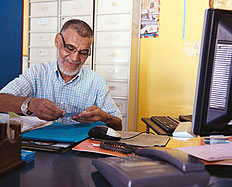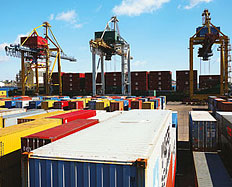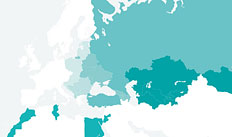Chapter 1
Country Transition Indicators
The SEMED countries score reasonably well on the country transition indicators, having benefited from the earlier opening up of their economies, along with substantial price and tariff liberalisation, through the reforms starting in the 1980s. In respect of “first-phase” transition reforms – small-scale privatisation, price liberalisation and trade and foreign exchange system – the four countries scored 4- or better with the exception of a 3+ rating for Egypt relating to price liberalisation (see Table 1.2). However, the scores for the remaining indicators – large-scale privatisation, governance and enterprise restructuring, and competition policy – were significantly lower.
| 0 | Large-scale privatisation | Small-scale privatisation | Governance and enterprise restructuring | Price liberalisation | Trade and foreign exchange system | Competition policy |
|---|---|---|---|---|---|---|
| Albania | 4- | 4 | 2+ | 4+ | 4+ | 2+ |
| Armenia | 4- | 4 | 2+ | 4 | 4+ | 2+ |
| Azerbaijan | 2 | 4- | 2 | 4 | 4 | 2- |
| Belarus | 2- | 2+ | 2- | 3 | 2+_ | 2 |
| Bosnia and Herzegovina | 3 | 3 | 2 | 4 | 4 | 2+ |
| Bulgaria | 4 | 4 | 3- | 4+ | 4+ | 3 |
| Croatia | 3+ | 4+ | 3+ | 4 | 4+ | 3 |
| Estonia | 4 | 4+ | 4- | 4+ | 4+ | 4- |
| FYR Macedonia | 3+ | 4 | 3- | 4+ | 4+ | 3- |
| Georgia | 4 | 4 | 2+ | 4+ | 4+ | 2 |
| Hungary | 4 | 4+ | 4- | 4+ | 4+ | 4- |
| Kazakhstan | 3 | 4 | 2 | 4- | 4- | 2 |
| Kyrgyz Republic | 4- | 4 | 2 | 4+ | 4+ | 2 |
| Latvia | 4- | 4+ | 3+_ | 4+ | 4+ | 4- |
| Lithuania | 4 | 4+ | 3 | 4+ | 4+ | 4- |
| Moldova | 3 | 4 | 2 | 4 | 4+ | 2+ |
| Mongolia | 3+ | 4 | 2 | 4+ | 4+ | 3- |
| Montenegro | 3+ | 4- | 2+ | 4 | 4+_ | 2 |
| Poland | 4- | 4+ | 4- | 4+ | 4+ | 4- |
| Romania | 4- | 4- | 3- | 4+ | 4+ | 3+ |
| Russia | 3 | 4 | 2+ | 4 | 4__ | 3- |
| Serbia | 3- | 4- | 2+ | 4 | 4 | 2+ |
| Slovak Republic | 4 | 4+ | 4- | 4+ | 4+ | 4- |
| Slovenia | 3 | 4+ | 3 | 4 | 4+ | 3-_ |
| Tajikistan | 2+ | 4 | 2 | 4 | 3+ | 2- |
| Turkey | 3+ | 4 | 3- | 4 | 4+ | 3 |
| Turkmenistan | 1 | 2+ | 1 | 3_ | 2+_ | 1 |
| Ukraine | 3 | 4 | 2+ | 4 | 4 | 2+ |
| Uzbekistan | 3- | 3+ | 2- | 3- | 2- | 2- |
| Egypt | 3 | 4- | 2 | 3+ | 4 | 2- |
| Jordan | 3 | 4- | 2+ | 4- | 4+ | 2 |
| Morocco | 3+ | 4- | 2+ | 4 | 4- | 2 |
| Tunisia | 3 | 4- | 2 | 4 | 4 | 3- |
Source: EBRD.
Note: The transition indicators range from 1 to 4+, with 1 representing little or no change from a rigid centrally planned economy and 4+ representing the standards of an industrialised market economy. For a detailed breakdown of each of the areas of reform, see the Methodological Notes on page [160]. # and ∃ arrows indicate one-notch upgrades or downgrades from the previous year. ## arrows indicate
a two-notch upgrade.
All four SEMED countries are members of the WTO and most have full current account convertibility and flexible exchange rates (except for Jordan, which maintains a fixed, but stable, exchange rate). Also, with economies heavily reliant on trade, they have removed almost all export and import restrictions (with a few sector exceptions, such as agriculture). There has been large-scale privatisation since the reforms of the 1980s, which is almost complete in Morocco, but there is still significant state involvement in key economic sectors in Egypt, Jordan and Tunisia. However, most smaller enterprises operate firmly within the private sector and there are no legislative barriers to ownership of land or capital.
Some of the greatest challenges concern competition policy and governance, where the four countries typically rank in the middle, or the lower half, of the transition spectrum. Competition policy implementation remains weak (except in Tunisia, where an independent competition authority is in line with international standards), and is hampered by weak enforcement, the continued presence of state monopolies and low institutional capacity. Although steps have been taken to create or improve competition agencies in Jordan, Egypt and Morocco, these still lack enforcement capability and/or independence. In general, there remains a significant shortfall between de jure institutional frameworks and their operation and effectiveness. All four countries score between 2 and 2+ on governance and enterprise restructuring, largely due to the continued subsidisation of key industries and poor governance at most state-owned enterprises. In particular, energy subsidies have created market distortions and state involvement has deterred private-sector participation.







